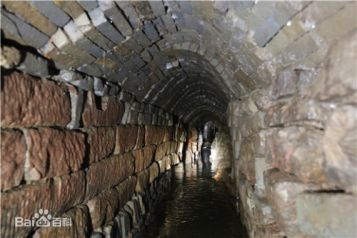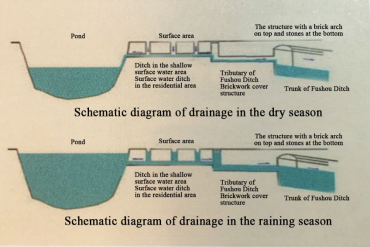Ganzhou city lies in the south of Jiangxi Province where the Zhangjiang River and the Gongjiang River converge. Being surrounded by waters in three sides, the whole city is confronted with a heavy pressure of flood. The Fushou Ditch System, commonly known as the “Fish Intestine Ditch”, is an underground drainage system of the ancient city of Ganzhou, with a total length of 12.6 km. During the Northern Song dynasty (A.D. 960-A.D. 1127), on the basis of predecessors’ endeavors and according to terrain features of Ganzhou city, Mr. Liu Yi, the mayor of Ganzhou city, built two underground ditches by the principle of zoning drainage, enabling rainwater and sewage in the city to naturally flow into the ditches and then be diverted to the Zhangjiang River and the Gongjiang River outside the city from the east and west directions.

In 1077, the Fushou Ditch System was completed after 10 years of construction, finally ending flood disasters in Ganzhou city. Local people thus protected their properties and gained happiness and longevity. Meanwhile, because the outlook of two ditches looks like “Fu” (good fortune) and “Shou” (longevity) in the seal script of the Chinese characters, the local people vividly name the drainage system as the “Fushou Ditch System”, which not only describes the appearance of the ditches but also conveys sound cultural implications. The Fushou Ditch System boasts of the following characteristics in the sphere of design and construction:
1. In the field of the craft, the Fushou Ditch System adopts the brick-arched structure, because it enjoys the lowest cost but the best gravitational force. Moreover, this structure enhances the bearing capacity of the ditch wall and prolongs the service life. The arched structure and the walls made of green bricks and hemp stones are intertwined to ensure the long service life of this underground waterway.

2. Natural imitation is one of the architectural characteristics of the Fushou Ditch System. Ganzhou city is located in a hilly region and the land form inside the city is undulating. Hence, the Fushou Ditch System follows its topography to employ different heights, widths and slopes, which is conducive to both speeding up water flow to rapidly discharge rainwater and flushing sediments in the Ditch to ensure smooth flow.
3. The drainage system of the Fushou Ditch System undertakes two major functions of storage during rainstorm and sewage discharge in normal times. Diverse drainage facilities are distributed in residential courtyards and kitchens. Consequently, sewage can be directly discharged from residents’ homes to the Ditch and then flow outside the city.
4. The bottom of the Fushou Ditch System is paved with stones, which has the effect of resisting acid, alkali, heat and corrosion in sewage.
5. The inscriptive bricks in the basement of the Fushou Ditch System record the names of the craftsmen, serving as a quality traceability system to ensure the project quality. Although the bricks have lasted for nearly 1,000 years, the inscriptions are still legible, proving outstanding craft level and craftsmanship of ancient people.
6. The concept of the Fushou Ditch System bears in mind the maximization of ecological benefits. the Fushou Ditch System is integrated with three big ponds and dozens of small ponds in the city, realizing comprehensive effects of water storage, fish farming, irrigation and sewage treatment. Furthermore, the ecological and environmental protection circulation chain formed thereby coincides with the present concept of sponge city.

The Fushou Ditch System has by far experienced a history of about 1,000 years. Thanks to its scientific, rational and practical architectural form, Ganzhou city takes advantage of water resources without suffering from floods for thousands of years. Besides, the Fushou Ditch System, still in use now, draws the world’s attention as a model of the underground drainage system of ancient Chinese cities. Meanwhile, its ingenious water system design still sheds light on today’s urban planning and construction.

